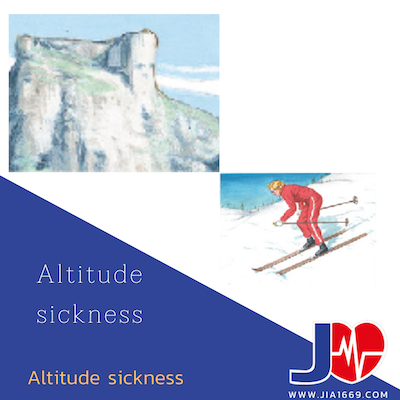altitude sickness
Last updated: 6 Aug 2024 | 3699 Views |


![]()
altitude sickness
As a result of high-altitude tourism, such as mountains, approximately 50% of people experience symptoms at 15,000 feet, men and women equally, most affecting people with lung problems. and people below the atmosphere
cause
In the high atmosphere, less oxygen is found. increased breathing and heart rate The high atmosphere causes the face, hands, and feet to swell, making the body unable to adjust. when at an altitude of 7000 – 8000 feet
symptom
Headaches, nausea and vomiting, rapid breathing, difficulty sleeping, lightheadedness, increased tiredness. Occurs after being at height 6-48 hours. Symptoms can be confused with alcohol dependence. Infections. Altitude pneumonia has a life-threatening effect. It is more common in adolescence. It is rarely a problem for mountaineers. initial symptoms inability to exercise vigorously Later symptoms such as coughing, tightness in the chest, rapid breathing, decreased alertness, symptoms of altitude sickness cause the brain to swell. resulting in headaches, walking problems, hallucinations
diagnosis
traveling to high places above sea level
Things to do
![]() The disease should be prevented at altitude by 2-4 days of adaptation at an altitude of 6000-8000 feet.
The disease should be prevented at altitude by 2-4 days of adaptation at an altitude of 6000-8000 feet.
![]() Ask your doctor to help prevent altitude sickness, such as Acetazolamide. Start first up and continue at the level.
Ask your doctor to help prevent altitude sickness, such as Acetazolamide. Start first up and continue at the level.![]() Height can have side effects such as nausea, tingling in the lips, fingers and toes.
Height can have side effects such as nausea, tingling in the lips, fingers and toes.![]() should rest enough
should rest enough![]() Should provide enough water and carbohydrates.
Should provide enough water and carbohydrates.
don't do
![]() Do not use alcohol and sleeping pills.
Do not use alcohol and sleeping pills.![]() Do not force yourself to be in high places when your body is not ready.
Do not force yourself to be in high places when your body is not ready.![]() Do not take acetazolamide. If allergic to sulfa drugs
Do not take acetazolamide. If allergic to sulfa drugs![]() Do not go to high places if you have a history of high altitude sickness.
Do not go to high places if you have a history of high altitude sickness.
Related content
Behcet's Disease
21 Sep 2022
Electrical Injury
15 Feb 2023
Laryngitis
19 Jul 2023
Exercise and Cardiovascular Health
18 May 2022












